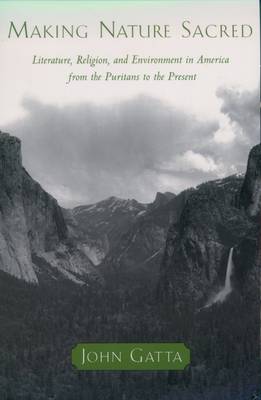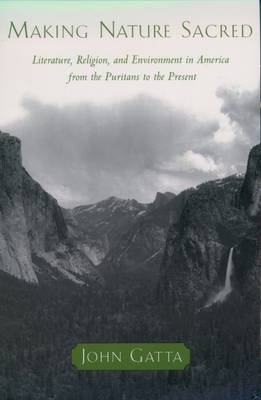
Je cadeautjes zeker op tijd in huis hebben voor de feestdagen? Kom langs in onze winkels en vind het perfecte geschenk!
- Afhalen na 1 uur in een winkel met voorraad
- Gratis thuislevering in België vanaf € 30
- Ruim aanbod met 7 miljoen producten
Je cadeautjes zeker op tijd in huis hebben voor de feestdagen? Kom langs in onze winkels en vind het perfecte geschenk!
- Afhalen na 1 uur in een winkel met voorraad
- Gratis thuislevering in België vanaf € 30
- Ruim aanbod met 7 miljoen producten
Zoeken
Making Nature Sacred
Literature, Religion, and the Environment in America from the Puritans to the Present
John Gatta
Paperback | Engels
€ 99,95
+ 199 punten
Omschrijving
Since colonial times, the sense of encountering an unseen, transcendental Presence within the natural world has been a characteristic motif in American literature and culture. American writers have repeatedly perceived in nature something beyond itself-and beyond themselves. In this book, John Gatta argues that the religious import of American environmental literature has yet to be fully recognized or understood. Whatever their theology, American writers have perennially construed the nonhuman world to be a source, in Rachel Carson's words, of "something that takes us out of ourselves."
Making Nature Sacred explores how the quest for "natural revelation" has been pursued through successive phases of American literary and intellectual history. And it shows how the imaginative challenge of "reading" landscapes has been influenced by biblical hermeneutics. Though focused on adaptations of Judeo-Christian religious traditions, it also samples Native American, African American, and Buddhist forms of ecospirituality. It begins with Colonial New England writers such Anne Bradstreet and Jonathan Edwards, re-examines pivotal figures such as Henry Thoreau and John Muir, and takes account of writings by Mary Austin, Rachel Carson, and many others along the way. The book concludes with an assessment of the "spiritual renaissance" underway in current environmental writing, as represented by five noteworthy poets and by authors such as Wendell Berry, Annie Dillard, Marilynne Robinson, Peter Matthiessen, and Barry Lopez.
This engaging study should appeal not only to students of literature, but also to those interested in ethics and environmental studies, religious studies, and American cultural history.
Making Nature Sacred explores how the quest for "natural revelation" has been pursued through successive phases of American literary and intellectual history. And it shows how the imaginative challenge of "reading" landscapes has been influenced by biblical hermeneutics. Though focused on adaptations of Judeo-Christian religious traditions, it also samples Native American, African American, and Buddhist forms of ecospirituality. It begins with Colonial New England writers such Anne Bradstreet and Jonathan Edwards, re-examines pivotal figures such as Henry Thoreau and John Muir, and takes account of writings by Mary Austin, Rachel Carson, and many others along the way. The book concludes with an assessment of the "spiritual renaissance" underway in current environmental writing, as represented by five noteworthy poets and by authors such as Wendell Berry, Annie Dillard, Marilynne Robinson, Peter Matthiessen, and Barry Lopez.
This engaging study should appeal not only to students of literature, but also to those interested in ethics and environmental studies, religious studies, and American cultural history.
Specificaties
Betrokkenen
- Auteur(s):
- Uitgeverij:
Inhoud
- Aantal bladzijden:
- 304
- Taal:
- Engels
Eigenschappen
- Productcode (EAN):
- 9780195165067
- Verschijningsdatum:
- 14/10/2004
- Uitvoering:
- Paperback
- Formaat:
- Trade paperback (VS)
- Afmetingen:
- 158 mm x 233 mm
- Gewicht:
- 430 g

Alleen bij Standaard Boekhandel
+ 199 punten op je klantenkaart van Standaard Boekhandel
Beoordelingen
We publiceren alleen reviews die voldoen aan de voorwaarden voor reviews. Bekijk onze voorwaarden voor reviews.









